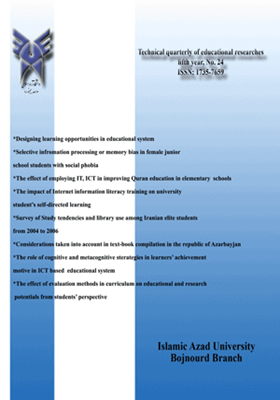Selective infromation processing or memory bias in female junior
Subject Areas : Educational Sciencehasan tozandeh 1 , mahmoud karimi 2
1 - استادیار دانشگاه آزاد اسلامی واحد نیشابور.
2 - کارشناس ارشد مدیریت آموزش
Keywords:
Abstract :
Researches related to excitement disorders and phenomenology had many advance during recent years. One of these research areas is examining the process of information processing in mental disorders. This research is of causal-comparative type which is done with the aim of examination of selective processing of information and the role of informative attention in this process in social phobic subjects. For this aim two groups of 20 people with social phobia and normal people were selected systematically and substitutional randomly and compared. Subjects were tested by Stroop test, recognition test and three questionnaires of social phobia disorder, Back depression and Spilbergers trait-state anxiety. One factor and two factor variance analysis tests with repeated measurements and Shefe pursuit test were used for data analysis. Results indicate that those who are social phobic spend more time processing symbols than control group. More processing of phobic signs is one of the other results of this research. There was a significant difference between cognition scores of two groups which confirms informativeness of processing process. There were no significant differences in examining the effects of different levels. But social phobic subjects who had higher level of depression spend more time processing the symbols. Also it became clear that age and educational variables had no effect on bias process. As related to the results achieved we can say that symbols content has been influential in color determination time. So interferential effect cannot be attributed to factors such as length of words, their difficulty or others factors. Also factors other than anxiety has been influential in slowness of patient performance. Presence of patterns proportional to threatening signs in memory and cognitive avoidance caused bias and informative processing.

